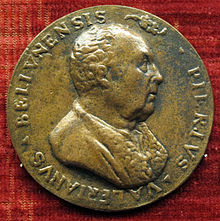Giovanni Pierio Valeriano Bolzanio
Giovanni Pierio Valeriano Bolzanio (* 1477 in Belluno , † 1558 in Padua also: Joannis Pieri Valeriani Bellunensi; Ioannis Pierii Valeriani; Ioannes Pierius Valerianus; own Giovan Pietro della Fosse; Pierio Valeriano; Bolzanio Pierio Valeriano; Pierius Valerianus was an Italian humanist) , Theologian and student of Andreas Johannes Laskaris .
Life
In his youth, Bolzanino studied with his uncle Urbano Bolzanio in Venice since 1493 . The uncle introduced him to the city's cultural circles and introduced him to Aldo Manuzio . He continued to have lessons in eloquence from Marcantonio Sebellico .
In Rome since 1509, he was involved in papal circles. With Julius II and the two subsequent Medici Popes Leo X and Clement VII as protectors, he received the cattedra d'elo puncta al Collegio Romano from Pope Clement VII , making him practically a lecturer at the papal university . Clement VII also made him tutor for Ippolito and Alessandro de 'Medici . With these two he stayed in Florence 1524-27. Then Valeriano went back to his native Belluno until he was appointed secretary by the Ippolito de 'Medici, who was appointed cardinal in 1529. After Ippolito's death he moved back to Belluno. Valeriano suffered his death in Padova in 1558 .
plant
In his early years in Rome, Valeriano wrote especially Latin poems of various genres (especially ode , epigram , elegy , fable ).
His most important prose work is Hieroglyphica, sive de sacris Aegyptiorum aliarumque gentium litteris commentariorum libri LVIII , which after its publication (1556) until 1668 saw seven reprints as well as translations into French (1576, 1615) and Italian (1602). It is the first renaissance symbol lexicon , written in 60 books with a total of almost a thousand folio pages. Each book deals with a picture from nature (animal, plant or body part).
He also wrote the Latin figure poem Pierius , which is considered the most important Italian representative of its form of the 16th century . It was written in 1549 and is in the shape of a pear. Gabriel Harvey still paid tribute to it.
bibliography
- Praeludia . Venice 1509.
- Amores (5 books) [completed in 1524, dedicated to Ippolito de 'Medici and given to him as a manuscript; first printed in Basel 1538 (see below) as an unauthorized collection of his odes, epigrams and other poems].
- Poemata . Basel: Robert Winter 1538.
- Amorum libri V. Appendix [= Amorum liber VI ] ex 'Praeludiis' castigatior. Amicitia Romana. Carpionis fabula. Protesialaos Laodamiae respon. Leucippi fabula lib. unus. Vinetia: Gabriel Giolittus de Ferrariis 1549.
- Hexametri, odae et epigrammata. Vinetia: Gabriel Giolito di Ferrariis 1550.
- Hieroglyphica. Basel 1556. [1] - French translation by Jean de Montlyard (1530 to approx. 1619).
- De litterarum infelicitate [not published before 1620].
literature
- Edgar Wind : Pagan Mysteries in the Renaissance (stw 697). Frankfurt a. M .: Suhrkamp 1981, Register sv [= London 1958, 2nd edition 1968].
- E. Iversen: The Myth of Egypt and its Hieroglyphs in European Tradition. Copenhagen 1961.
- Alessandro Perosa / John Sparrow (edd.): Renaissance Latin Verse. An Anthology. Chapel Hill: Univ. of North Carolina Press 1979, pp. 187-192.
Web links
- Literature by and about Valeriano Pierio in the catalog of the German National Library
- http://www.italica.rai.it/rinascimento/parole_chiave/schede/cmitog3.htm (Italian)
- http://www.uni-mannheim.de/mateo/camenaref/valeriano.html (Latin)
| personal data | |
|---|---|
| SURNAME | Bolzanio, Giovanni Pierio Valeriano |
| ALTERNATIVE NAMES | Joannis Pieri Valeriani Bellunensi; Ioannis Pierii Valeriani; Ioannes Pierius Valerianus; Giovan Pietro della Fosse (real name); Pierio Valeriano; Bolzanio, Pierio Valeriano; Pierius Valerianus |
| BRIEF DESCRIPTION | Italian humanist and theologian |
| DATE OF BIRTH | 1477 |
| PLACE OF BIRTH | Belluno |
| DATE OF DEATH | 1558 |
| Place of death | Padua |
